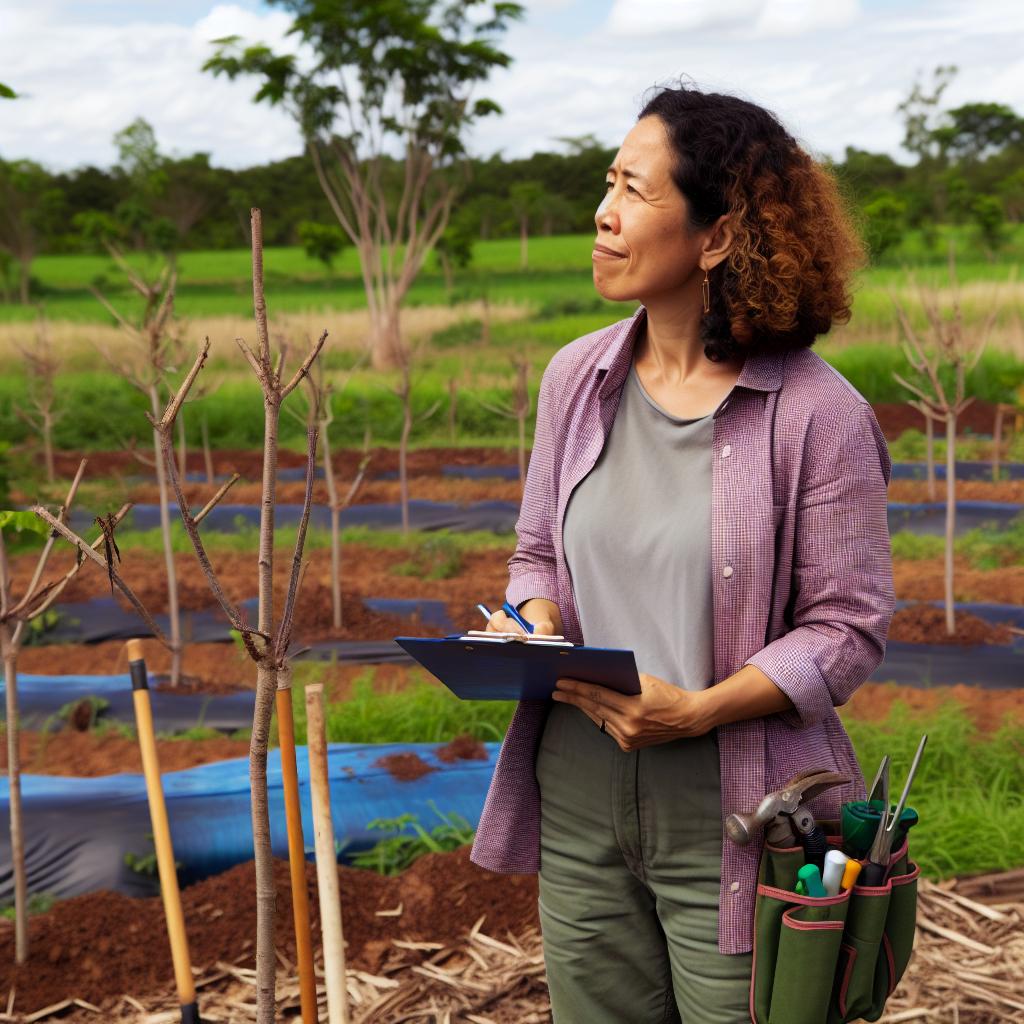Overview of Permaculture and Agroforestry Principles
Permaculture Fundamentals
Permaculture emphasizes sustainable agricultural practices.
It designs ecosystems that mimic natural processes.
This approach enhances biodiversity and soil health.
Furthermore, it promotes efficient resource use.
Key principles include observation, design, and management.
Also, permaculture values cooperation over competition.
Agroforestry Basics
Agroforestry integrates trees and shrubs into agricultural systems.
This method increases farm productivity and resilience.
Importantly, it provides multiple environmental benefits.
For instance, it enhances carbon sequestration.
Additionally, agroforestry improves soil fertility and structure.
Complementary Principles
Both permaculture and agroforestry focus on holistic practices.
They promote biodiversity, enhancing ecosystem functions.
Moreover, they prioritize resilience in agricultural systems.
By mimicking nature, they create self-sustaining environments.
Transform Your Agribusiness
Unlock your farm's potential with expert advice tailored to your needs. Get actionable steps that drive real results.
Get StartedThese techniques reduce reliance on chemical inputs.
Benefits of Sustainable Practices
Sustainable land use provides numerous benefits.
- Improved soil health and fertility
- Enhanced water retention and quality
- Increased biodiversity on farms
- Creation of habitats for wildlife
- Support for local food systems
Additionally, these practices help combat climate change.
Ultimately, they ensure food security for future generations.
Benefits of Integrating Permaculture with Agroforestry for Sustainable Land Use
Integrating permaculture with agroforestry boosts biodiversity on the land.
This combination creates diverse habitats for wildlife.
Additionally, it encourages a variety of plant species to thrive.
Enhanced Biodiversity
Permaculture practices enhance soil health through natural methods.
Cover crops, crop rotation, and mulching keep the soil fertile.
Thus, agroforestry adds organic matter, improving water retention.
Improved Soil Health
Combining these techniques leads to greater crop resilience against pests.
Integrated systems reduce the need for chemical pesticides.
They also promote natural pest control through diverse ecosystems.
Increased Crop Resilience
These methods optimize resource use, ensuring sustainability.
Water is utilized more efficiently through synergistic planting.
Furthermore, trees provide shade and windbreaks for crops.
Efficient Resource Use
Integrating permaculture with agroforestry can boost farm income.
Diverse products can be harvested, increasing market potential.
Additionally, agroforestry systems may qualify for subsidies and grants.
Economic Benefits
This integrated approach helps in mitigating climate change effects.
Trees sequester carbon, reducing greenhouse gases in the atmosphere.
Moreover, these systems enhance resilience to changing climate patterns.
Climate Change Mitigation
Key Permaculture Techniques Used in Agroforestry Systems
Agroecological Design
Agroecological design combines agriculture and ecology effectively.
This technique focuses on creating diverse ecosystems.
Showcase Your Farming Business
Publish your professional farming services profile on our blog for a one-time fee of $200 and reach a dedicated audience of farmers and agribusiness owners.
Publish Your ProfileIt utilizes the natural relationships between plants and animals.
Furthermore, it aims to enhance soil fertility and biodiversity.
Plant Guilds
Plant guilds consist of mutually beneficial plants growing together.
These groups enhance resource efficiency in agroforestry systems.
For example, legumes fix nitrogen, benefiting adjacent plants.
Moreover, some plants provide shade and wind protection.
Diversity of Species
Diversity is a cornerstone of permaculture and agroforestry.
Having various species promotes resilience to pest outbreaks.
It also enhances the overall health of the ecosystem.
Agroforestry systems can integrate trees, shrubs, and crops effectively.
Water Management Techniques
Effective water management is crucial in agroforestry systems.
Techniques include creating swales and rain gardens.
These structures capture and retain water efficiently.
In addition, they minimize soil erosion and runoff.
Companion Planting
Companion planting enhances crop yields through beneficial interactions.
This technique improves pest control and nutrient availability.
For instance, planting herbs alongside vegetables can deter pests.
Additionally, some plants can attract pollinators to the area.
Mulching and Ground Cover
Mulching helps retain soil moisture and suppress weeds.
Various materials can serve as effective mulch options.
Ground cover plants prevent soil erosion and promote biodiversity.
These techniques contribute to a healthier agroecosystem.
Learn More: DIY Garden Projects for No-Till Gardening
Designing an Agroforestry Layout
Understanding the Site Conditions
Begin by assessing the specific site conditions.
Evaluate soil quality, moisture availability, and climate factors.
Additionally, consider existing vegetation and wildlife presence.
Understanding these elements guides your planning process.
Selecting the Right Species
Choose plants that complement each other’s growth needs.
Focus on native species to enhance biodiversity.
Include a mix of trees, shrubs, and herbaceous plants.
Consider the mature size and root structures of selected plants.
Creating Microclimates
Design layout to create beneficial microclimates.
Use taller trees to offer shade to smaller plants.
This strategy conserves soil moisture and protects from winds.
Mixing species can also support diverse habitats.
Implementing Companion Planting
Utilize companion planting for improved yields.
Pair plants that have mutually beneficial relationships.
For instance, legumes can enhance nitrogen levels in the soil.
Use ground cover plants to suppress weeds and retain moisture.
Incorporating Water Management Strategies
Plan for effective water management within the layout.
Showcase Your Farming Business
Publish your professional farming services profile on our blog for a one-time fee of $200 and reach a dedicated audience of farmers and agribusiness owners.
Publish Your ProfileConsider swales and contour beds to manage runoff.
Implement rainwater harvesting systems to enhance water availability.
These strategies contribute to overall sustainability.
Designing for Accessibility
Ensure that paths and access points are practical.
Make movement through the site easy for maintenance and harvesting.
Clearly mark areas for planting and harvesting to enhance efficiency.
Accessibility boosts overall productivity and enjoyment.
Monitoring and Adapting the Layout
Regularly monitor plant growth and ecosystem health.
Be prepared to adapt the layout based on observed results.
This iterative process improves long-term sustainability.
Embrace changes that nature presents within your agroforestry system.
See Related Content: Using Native Pollinators To Enhance Biodiversity In Community Garden Spaces
Soil Health Management in Permaculture Agroforestry
Understanding Soil Health
Solar health is essential for sustainable land use.
Healthy soil supports diverse plant and animal life.
It functions as a dynamic ecosystem with active biological processes.
Furthermore, maintaining soil health improves water retention.
This, in turn, reduces the need for irrigation.
Techniques for Enhancing Soil Fertility
Organic matter plays a key role in enhancing soil fertility.
Composting is a simple, effective method to enrich soil.
Cover cropping prevents soil erosion during off-seasons.
These crops also add nutrients back into the soil.
Practices to Promote Soil Biodiversity
Diverse planting strategies boost soil biodiversity.
Agroforestry integrates trees with crops, enhancing ecosystem complexity.
Rotational grazing systems can also improve soil health.
These systems encourage nutrient cycling and prevent soil compaction.
Soil Testing and Monitoring
Regular soil testing is vital for understanding soil health.
This process identifies essential nutrients and pH levels.
Using this information helps tailor soil amendments effectively.
Monitoring soil health continuously ensures long-term sustainability.
Implementing Carbon Farming Techniques
Carbon farming captures carbon in soil and vegetation.
This practice improves soil structure and fertility significantly.
Incorporating perennials contributes to carbon sequestration.
Additionally, it enhances resilience against climate change impacts.
Key Takeaways
- Soil health is the foundation for successful permaculture.
- Techniques like composting and cover cropping enhance fertility.
- Diversity in planting boosts ecosystem resilience.
- Regular soil testing informs management strategies.
- Carbon farming contributes to both soil health and climate mitigation.
You Might Also Like: Community Gardens for Growing Herbs and Medicinal Plants

Water Management Strategies in Permaculture Agroforestry Systems
Understanding the Importance of Water
Water is vital for all life on Earth.
In permaculture agroforestry systems, effective water management is crucial.
It enhances soil health and crop yields.
Moreover, it helps maintain local ecosystems.
Designing for Water Capture
Utilizing swales is an excellent technique for water management.
These shallow trenches hold rainwater effectively.
Showcase Your Farming Business
Publish your professional farming services profile on our blog for a one-time fee of $200 and reach a dedicated audience of farmers and agribusiness owners.
Publish Your ProfileAdditionally, they reduce erosion and promote soil moisture.
Rain gardens also serve to capture excess water.
They filter pollutants, benefiting both plants and wildlife.
Incorporating Water-Resilient Planting Techniques
Selecting drought-resistant crops conserves water resources.
Planting cover crops prevents soil erosion and retains moisture.
Additionally, native plants adapt well to local conditions.
Thus, they require less water over time.
Using Mulching for Moisture Retention
Applying organic mulch aids in moisture retention.
This layer of material slows evaporation.
Moreover, it suppresses weed growth and enriches the soil.
Regularly replenishing mulch ensures sustained benefits.
Implementing Greywater Systems
Recycling greywater maximizes water use efficiency.
This system captures water from sinks or showers.
When treated properly, it nourishes plants effectively.
Such systems reduce overall water consumption significantly.
Monitoring Water Quality
Regularly testing water quality ensures it meets safety standards.
This practice prevents contaminants from harming crops and ecosystems.
Utilizing bio-indicators provides additional insights into water health.
Adapting to Local Climate Conditions
Understanding regional climate informs water management practices.
Adjusting strategies to seasonal variations enhances resilience.
Furthermore, practicing landscape contouring optimizes water flow.
This method directs water strategically across the land.
Community Collaboration for Resource Sharing
Cultivating community partnerships aids in resource management.
Exchanging knowledge and resources helps optimize water use.
Collaborative efforts lead to shared benefits among local farmers.
This approach enhances the sustainability of water management strategies.
Discover More: Small Livestock Management for Beginners in Homesteading
Crop Diversity and Companion Planting in Permaculture Agroforestry
Importance of Crop Diversity
Crop diversity is essential for resilient agricultural systems.
It promotes a variety of plant species in a given area.
This practice enhances ecosystem stability and disease resistance.
Moreover, diverse crops can utilize resources efficiently.
In addition, they foster beneficial interactions among species.
Soil Health and Nutrient Management
Healthy soil is the foundation of productive agroforestry.
Diverse cropping prevents nutrient depletion in the soil.
Leguminous plants can fix nitrogen, enriching the soil.
Furthermore, cover crops can prevent erosion and maintain structure.
Overall, healthier soil supports more robust plant growth.
Companion Planting Strategies
Companion planting enhances mutual benefits among plants.
Certain pairs can improve growth, deter pests, and attract pollinators.
For example, tomatoes and basil thrive together.
Showcase Your Farming Business
Publish your professional farming services profile on our blog for a one-time fee of $200 and reach a dedicated audience of farmers and agribusiness owners.
Publish Your ProfileThey enhance each other’s flavor and repel pests.
Additionally, corn, beans, and squash exemplify the “Three Sisters” principle.
Benefits of Companion Planting
Companion planting optimizes space and resources.
This method minimizes the need for chemical inputs.
It encourages a natural form of pest control.
Moreover, it supports biodiversity in agroforestry systems.
Ultimately, this practice leads to a healthier ecosystem.
Implementing Crop Diversity and Companion Planting
Start by assessing the local soil and climate conditions.
Plan your planting arrangement carefully for synergistic benefits.
Finally, monitor the system and make adjustments as needed.
Continuous learning enhances the effectiveness of these techniques.
Incorporating diverse crops and companion planting will yield long-term benefits.
Case Studies: Successful Examples of Permaculture Agroforestry Around the World
Introduction to Case Studies
Permaculture agroforestry has proven effective globally.
Various regions showcase unique adaptations of the technique.
Each case contributes valuable insights into sustainable practices.
Example in Malaysia: The Desa Murni Project
The Desa Murni Project in Malaysia highlights agroforestry success.
This initiative integrates fruit trees with annual crops.
Farmers in the area benefit from increased yields.
Additionally, biodiversity flourishes in the diverse habitats.
Local communities gain economic stability from these practices.
Case Study from Brazil: The Agroforestry Network
In Brazil, the Agroforestry Network supports sustainable land use.
This network connects farmers employing permaculture techniques.
Members share knowledge and resources effectively.
As a result, they experience enhanced soil health and productivity.
Furthermore, they combat deforestation through these sustainable methods.
Innovative Practices in Australia: The Yalwal Forest Project
The Yalwal Forest Project in Australia showcases innovation.
This project combines native trees with agroecological practices.
Farmers restore ecosystems while cultivating crops.
Consequently, they nurture wildlife habitats alongside agricultural output.
This project serves as a model for sustainable land management.
Insights from Africa: The Great Green Wall Initiative
The Great Green Wall Initiative spans several African countries.
This vast program aims to combat desertification through agroforestry.
Farmers plant trees alongside crops to improve resilience.
Additionally, this practice enhances soil quality and water retention.
Overall, communities gain food security and sustainable livelihoods.
Reflections on Global Themes
These case studies reveal common principles underlying success.
Community involvement remains crucial for effective implementation.
Furthermore, diverse ecosystems offer resilience against climatic changes.
Sharing knowledge enhances the replication of successful practices.
Ultimately, these examples inspire future agroforestry initiatives.
Showcase Your Farming Business
Publish your professional farming services profile on our blog for a one-time fee of $200 and reach a dedicated audience of farmers and agribusiness owners.
Publish Your ProfileAdditional Resources
What is Syntropic Farming?: A Permaculture Perspective — Porvenir …




